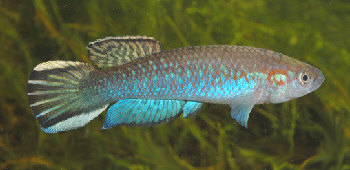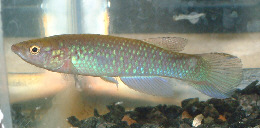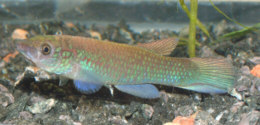Archiaphyosemion guineense (Daget 1954)

Kissidougou, Guinea. Photo courtesy of Tony Terceira.
| Meaning of Name |
After Guineé, the native country of the species. | ||||||
| First Description |
Daget J. 1954. Les Poissons du Niger supérieur. Mémoires de l'Institut français de l'Afrique noire (I.F.A.N.) 36: 315-316, figure 119. | ||||||
| Size |
6.5 cm (Radda & Pürzl 1987). | ||||||
| Meristics |
| ||||||
| Karyotype |
n = 19, A = 24 (Scheel 1968, 1990) | ||||||
| Sub-Genus |
| ||||||
| Group |
maeseni | ||||||
| Synonyms |
| ||||||
Populations
|
Bagdwe - Collected by Norman in 1932. Banian - Collected by Daget in 1954. Benamana
- Collected by Daget in 1954. Dabola - Collected by Daget in 1954. Kissidougou
- Collected by Daget in 1954. Lago - Collected by Roloff in 1965. Lenghe Curoh - Collected by Busch & Wiese in 1993 (SL 93 code). Loma Mountains - Collected by Schoitz in 1963. Panguma - Collected by Roloff in 1965. Sandaru - Collected by Norman in 1932. Simandou - Collected by Daget in 1954. Tinkisso - Collected by Daget in 1954. | ||||||
| Type Locality |
Dabola, on the Tinkisso Falls, Banamana, Banian, Simandou & the surroundings of Kissidougou, upper Niger drainage in eastern Guineé). | ||||||
| Distribution |
The upper Niger River drainage in Guineé & other drainage systems of northern Liberia & northeastern Sierra Leone which flow towards the sea. | ||||||
| Habitat |
Small streams & pools found in savannah. Scheel reported them being restricted to mountain areas although he mentions that the population from Lago is not a mountain population. This population was found with Script. bertholdi & E.fasciolatus with Call.occidentale being found not far from this locality. Daget has reported that guineense is only present where E.spilargyreius & E.bifasciatus are absent. | ||||||
| Distinguishing Characteristics | Males are distinctively green in colouration. No red pigment is obvious on the fish although some can be seen through a microscope. This is usually found behind the eye or around the root of the pectoral fins.Females are reported as being 'very chunky'. | ||||||
| Colour/Pattern Variability | This is a fairly plain looking species. I would consider this to be fairly low in variability regarding any striking pattern differences. | ||||||
| History |
In 1954 Daget received 102 specimens from various localities in the Upper Niger drainage, these being Banian, Dabola, Tinkisso & Simandou. He used these with Pellegrin's 1934 collection to describe the species. Prior to this date (1932) Norman identified specimens of guineense as cameronense from Bagbwe & Sandaru in Sierra Leone, which is well outside the range of cameronense. Scheel in ROTOW 1 considered these were guineense. In 1934 specimens were reported from Banamanan & Kissidougou, High Guinee by Pellegrin but again these were thought to be cameronense. Scheel & Daget both considered these to be guineense. In 1958 Lambert reported 13 individuals of guineense from High Guinée Roloff caught 3 female specimens in 1962 in Sierra Leone. One was lost but the other two were sent to Scheel for study. In 1963 Schiötz caught them in the Loma Mountains, northern Sierra Leone. Many of these were sent to Scheel but they arrived dead Roloff again caught guineense in 1965 near Lago & Panguma, eastern Sierra Leone. Specimens from this collection were successfully spawned & an aquarium strain was developed of the Lago population by Scheel. He reported a distinctive faint red reticulation along the sides of males of this population Caught in 1978 by Romand, Schmitt & Guignard at Fouta Djalon Romand & Schmitt also caught them near Macenta & Kissidougou, Guinee. In 1982 Etzel & Pürzl caught them on a trip to Liberia. | ||||||
| Breeding Notes |
Prefers larger tanks with well oxygenated water. Eggs are found mostly in the lower areas of the tank according to some breeders & near the surface by others. . Scheel, in ROTOW 1 reports that the eggs 'develop & hatch without delay'. Reportedly not an easy species to breed. Incubation is variable. Reports quote hatching at 8 days in a water temperature of 70'F & 13 days at 76'F. Growth rate is quite fast with sexing out reported at around 6 months. Fry on hatching are quite large & capable of taking newly hatched brine shrimp. Males in breeding condition are said to display black colouration to the lower head area with the whole body becoming darker. Females display a dark oblong marking pattern down the sides. This pattern may be unique to this species. In BKA newsletter No.53, January 1970 Dick Armstrong reported that they take some time to colour up, but found them easy to spawn. Eggs were laid in top mops near the top & floating plants. Water incubation took around 10 days. The young grew very quickly with good feeding. It was noted that they appreciate water changes. A variety of water conditions are tolerated by this sp. from hard to soft although soft acid water shows the fish at their best. | ||||||
| Diameter of Egg | 1.6 mm. | ||||||
| Remarks |
Sexing out may not fully become identifyable until they reach 3-4 cm. These fish are heavy eaters. Not reported to be a shy fish. The drab colouration of the species probably seals their fate as a long term captive bred fish but they should be found in groups specialising in the old Roloffia forms. This sp. exhibits territorial behaviour. |



